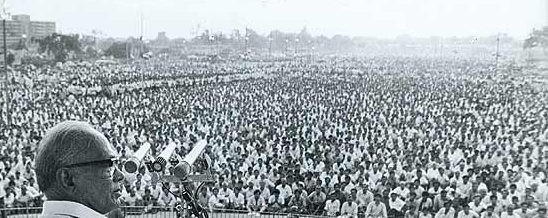The National Crime Records Bureau publishes a very interesting report every year. The title is very simple – Crime in India. The report is interesting for two reasons. One, the entire report only contains numbers and statistics. Considering the magnitude of significance of such a report, it seems very peculiar that the makers of the report have not inserted their own interpretations and inferences that could have been drawn from these 400 pages of numerical data. The reason why they did not do that is the second feature of this report that makes it interesting. The report is a textbook example of the classic adage – the numbers speak for themselves. Going through any five random pages of this report is enough to make one feel completely disgusted.
While you are at it, I would like to recommend a particular section in the report. Under the chapter ‘Crimes against women’, there is a column called ‘Rape’. You won’t be particularly surprised to learn that in the year 2011 (the report for 2012 has not been released yet), the incidence of rapes rose at a rate higher than any of the previous years. The number of rapes in 2011 stands at 24,206 which is 9% higher than the previous year. This means that on an average, a rape occurred in India every twenty minutes in the year 2011. Even though the situation has been very pathetic since a long time, nothing significant had ever been done about it. The public outrage that broke out after the appalling incident of the Delhi gang-rape has, for the first time brought some serious attention towards this issue in India.
How deep has the blade sunk?
Out of the 24, 206 rape incidents, 7,112 incidents were the ones committed against minors. This means one out of every three rape victims is a child (the children being as young as 3 years old). Also, the top 88 cities of India accounted for 10% of all rape incidents. These are the cities with sound policing systems and relatively open-cultured societies. Think about the 90% incidents which take place in semi-urban and rural areas. These are the kinds of places where women are beaten and harassed for petty issues and then locked up in cowsheds where they are starved and made to introspect upon their sis of being born as a girl. Also, the police in these areas are not as brilliant’ as their counterparts in the big cities. Most of the cases in these areas are never even reported. The pace of our judicial proceedings is also not something we can take pride upon either. At the start of 2011, there were 95 thousand cases of rapes pending in courts. By the end of the year, the courts had come out with merely 4 thousand convictions and still stuck with 80 thousand pending cases for the next year.
In India, it is not just the act of rape that makes one strongly resent the crime itself. It is the manner in which it is done and to the people to whom it is done that makes one feel thoroughly disgusted. The Delhi gang-rape victim had 80% of her intestines, literally pulled out and thrown away. There are many incidents where on hearing the cries of a girl being raped, people came as rescuers but then changed their minds and decided to join the party as well. Gang-rapes of 4 year olds have also been reported. Orphaned children are very often taken advantage of by their own guardians or relatives. Hundreds of tourists who came to India to explore the country’s rich culture have gone back scarred for life. Even worse is the fact that our Indian society is not built of men who support or welcome rape victims with an open heart. The victims are most often, ostracized and isolated which is the biggest rationale behind the proposition that the actual number of rapes might be much more than the reported figure.
What makes rapes so prominent everywhere in India?
The problem of rapes is now a serious matter of concern in all states. But still, regional variations exist. At least 2% of the population of India became victims of rape in 2011. But, state wise data show variations between 0.7 and 7.1 percent in different states. A single look at these numbers is enough to indicate the inadequacy of the data (actual figure vs. reported figure) and the broad reasons why rapes occur at the frequency that it does in India.
The first reason is the systemic encouragement that this sort of a crime gets due to the weak legal structure of our anti-rape laws, slow judicial disposal of the pending rape cases and inefficient policing. In order to get justice, the rape victim has to first approach a completely insensitive police which already has hundreds of cases in the queue. Government figures suggest that out of the total number of rape cases with the police, 1 out of every 3 cases is a case pending from last year. Only in 1 out of 20 cases does the final report by the police declare the charges to be true. The cases which go to the court take a further 3-5 years, on average. Only in 1 out of 4 cases is ‘sufficient’ proof produced before the court for a conviction to actually take place. But, now hopefully the scenario is changing in a positive way with a strong Anti-rape Bill already passed by the Lok Sabha and very soon to be put up before the Rajya Sabha as well. Also, fast track courts for rape cases have been introduced which will ensure speedy delivery of justice. But apart from the judicial factor, there is another factor which basically is the root cause of this problem.
The second reason is the cultural encouragement that this crime gets due to the parochial gender-based segregation that our society still suffers from. As a result of this, the dynamics of power shifts in favour of the man and leaves the woman in a state of complete helplessness. The atrocities taking place against women in this country are so conspicuous to the extent that they take place in almost every family in some way or the other. Female feticides, domestic violence, dowry deaths, abduction, sex trafficking, are all serious problems that we face even to the present day. These issues by themselves reflect the most repulsive traits of the kind of society in which we live in. Even though a strong anti-rape bill is in the passage of becoming a law, we also need to think about the cultural factor regarding this issue.
What can we as citizens, do?
It is true that the anti-rape law will significantly affect the number of rapes in India. But that in itself would not be enough if we want to build a nation where women can walk fearlessly. Just like every other issue in India, this issue also cannot be solved if we only look at the issue specifically. People, especially males should actively participate in citizen movements and NGOs that work in any feminist issues. Violators are more often uneducated or very little educated. This obviously does not mean educated people do not commit this crime. But the fact cannot be ignored that education is a significant factor for many crimes, especially ones committed against women. Citizens should contribute in whatever way they can, to the process of promoting education for children. The very least everybody can do is to ensure that no one from one’s own family and friends become perpetrators of any atrocity against women, big or small. The root cause of any crime against women in India is the inability of men to see women as their equals. The day we get over that would be the day when the Indian women would fully reclaim her dignity.
For the NCRB report, please click on the following link:






